Este Navidad, no tiraremos de las recetas de la Abuela Paquita. Pero sí, de las recetas típicas de las Abuelas Centro Europeas que hacen de estas fechas tan señaladas el recuerdo encantador de una Navidad en Familia.
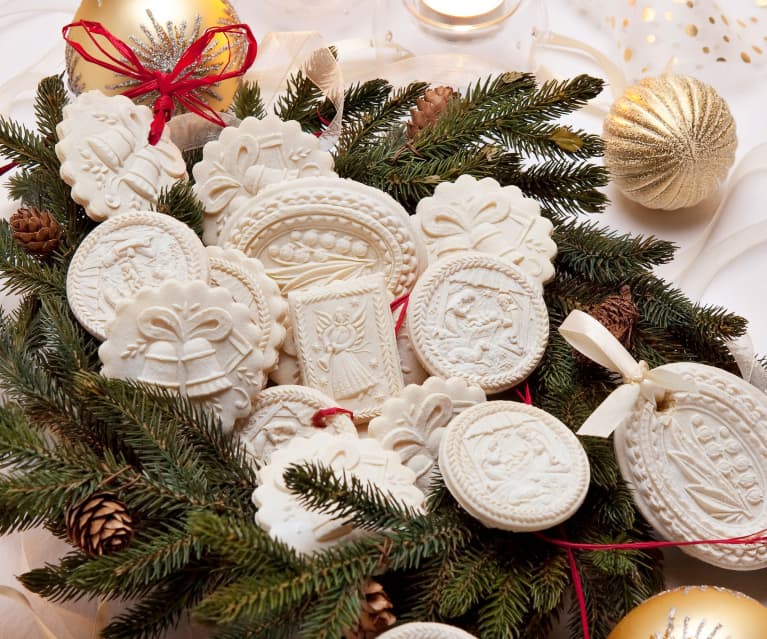
Historia de las galletas Springerle
Las galletas Springerle son unas preciosas galletas oriundas de Centroeuropa, es decir, Alemania, Suiza y algo de Francia, tradicionales para Navidad, son galletas blancas con sabor a anís que llevan una imagen de distintos motivos estampada sobre su superficie. Las imágenes se imprimen presionando la masa con rodillos de madera o con moldes planos finamente tallados en madera.
La historia de las galletas Springerle se remonta a casi mil años atrás, las tribus germánicas durante la celebración del solsticio de Invierno realizaban sacrificios de animales como ofrenda al dios Wotan (Odín) rey supremo de los dioses nórdicos, el caballo era considerado un animal sagrado para estas tribus y la palabra Springerle proviene de un antiguo dialecto alemán que significa algo similar a “pequeño caballo de salto”.

Ya que la gente pobre no podía permitirse sacrificar a sus animales realizaban galletas en forma de animales para ofrecerlas como sacrificio al dios Wotan.
Hoy en día, aún sobreviven algunos vestigios de esas prácticas paganas en las formas y grabados de los moldes de Springerles, con escenas de animales y de estas festividades.

En la edad media, con la inclusión del 25 de Diciembre en el calendario cristiano se continuó con esta tradición de las galletas estampadas, reemplazando los diseños paganos por motivos cristianos, los hornos de los monasterios que proveían de dulces y panes a la realeza fueron los que mayor influencia tuvieron al reemplazar los antiguos motivos en las Springerle incorporando los diseños religiosos que dominaron este período.

La primera receta de Springerle apareció en un libro de cocina de 1688, estas galletas se volvieron muy populares entre 1600 y 1800 cuando los artesanos comenzaron a fabricar moldes y rodillos tallados y grabados en madera con intrincados y finos detalles decorativos, los diseños tenían un importante significado simbólico: Fertilidad, virilidad, amor, etc., posteriormente también se incorporaron diseños con flores, frutas y detalles de la vida cotidiana de la época. La mayoría de los moldes de este período se encuentran en museos Europeos o en colecciones privadas.
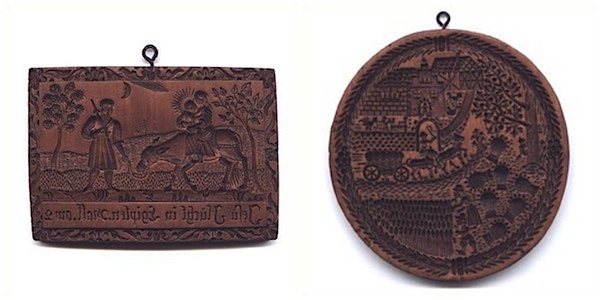
Los moldes de Springerle son valorados como un tesoro familiar que ha pasado de generación en generación de madres a hijas a través de los siglos junto con las antiguas recetas celosamente guardadas.
Galletas Springerle
Se caracterizan por sus delicados relieves, que se mantienen en la cocción gracias a que después de imprimirlas con un molde, estas se dejan secar hasta un día entero.
Estas galletas se preparan únicamente con huevos, azúcar glas y harina, y es tradicional aromatizarlas con anís.
Su consistencia es dura por lo que se conservan muy bien y normalmente se dejan madurar alguna que otra semana antes de consumirlas. Por esa consistencia y por su facilidad de conservación son ideales para regalar (ya que pueden conservarse hasta tres meses).
Las galletas springerle incluyen tradicionalmente un ingrediente curioso: el carbonato amónico, un impulsor químico anterior a la levadura química comercial.
Este componente hace que las galletas queden más crujientes que con la levadura ordinaria y ayuda a que los motivos se mantengan más nítidos en la cocción.
Sin embargo, no es imprescindible y es perfectamente posible hacer las galletas con levadura corriente.
Cómo hacer Galletas Springerle :
Ingredientes
– 3 huevos medianos (a temperatura ambiente)
– 400 g de azúcar glas
– 60 g de mantequilla pomada
– 1 cdta. de aroma de anís
– 1/4 cdta. de sal
– 1/2 cdta. de carbonato amónico (hartshorn) o de levadura química
– 500-520 g de harina de repostería
* Moldes para galletas springerle.
Elaboración
En primer lugar se ha de pesar o medir la harina, la sal y el impulsor químico que vayamos a usar (ya sea levadura o carbonato amónico) y se tamiza todo junto.
Y se reserva.

En un bol, se han de poner los huevos, tamizando sobre ellos el azúcar glas. Se ha de montar con unas varillas eléctricas o un robot con varillas a velocidad alta, hasta que blanqueen bien y hayan aumentado de volumen. Hay que tener en cuenta que se necesitará batir por lo menos 15 minutos.
Pasado el tiempo necesario, a velocidad media se añade la mantequilla hasta que se mezcle. Y se agrega el aroma de anís.
A velocidad baja; se va añadiendo la mezcla de harina a cucharadas, hasta incorporarla toda. Debiendo obtener una masa blandita y que se pegue algo a los dedos.
Sobre la encimera enharinada, se pone la masa que se ha obtenido. Pasamos la masa a la encimera enharinada. Y se amasan ligeramente.
* Hay que enharinar de manera homogénea, pero ligera porque cuanta más harina absorbe la masa más dura se pone.
Si está demasiado pegajosa se añade algo más de harina y se amasa nuevamente, pero con precaución ya que es una masa que se reseca enseguida solamente con la harina que se utiliza para que no se pegue.
* Para saber si la masa está en su punto se puede estirar con rodillo una pequeña porción y aplicar algún molde.
Si la masa está en el punto de humedad preciso no debe quedar pegada en absoluto al molde y debe reflejar perfectamente hasta el último detalle.
Si se pega al molde, se ha de añadir harina poco a poco.
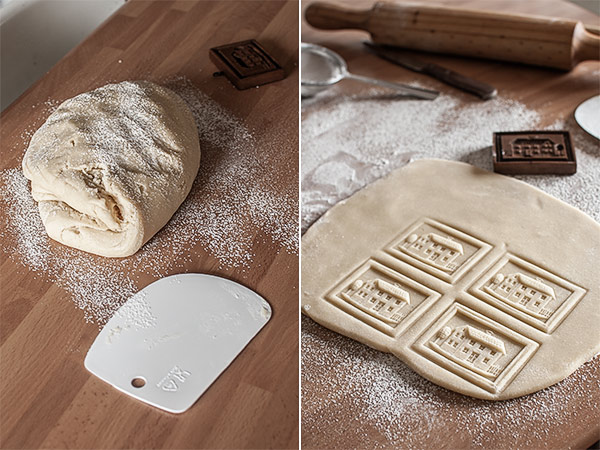
Una vez que la masa esté lista, se toma una porción de la masa, (entre un tercio y un cuarto)
* Se mantendrá la masa sin usar; bien envuelta en un plástico, para que no se reseque.
Utilizando la masa que se va a utilizar, esta se estira con el rodillo hasta 1 cm de espesor y se aplica el molde, presionando fuerte.
* Se puede aplicar el molde tantas veces como el espacio permita, no muy cerca un dibujo de otro, pues al apretar el molde en un punto la masa tiende a deformarse en las proximidades.
** Otro método es cortar la galleta correspondiente cada vez que se aplique el molde.
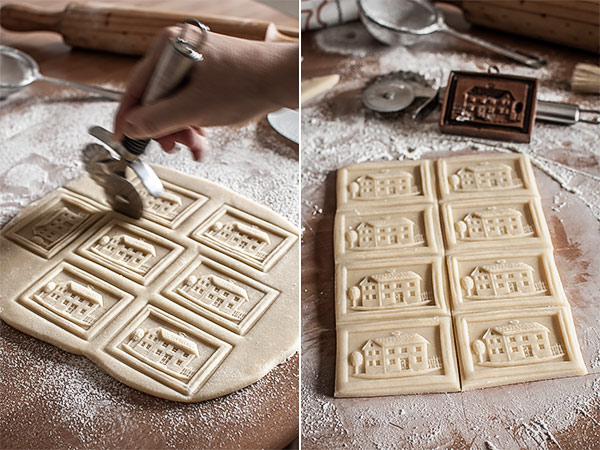
Los recortes de masa se pueden aprovechar perfectamente, se juntan y se vuelven a estirar. Se debe trabajar en todo momento con la masa enharinada de forma fina y homogénea por debajo y solo muy ligeramente por arriba, donde se apliquen los moldes.
* Por otro lado, si la masa se queda algo seca en algún momento, añadiremos una pizca de agua, aunque solo sea mojándonos las manos, y amasaremos ligeramente.
Se van poniendo las galletas cortadas (con cuchillo, cortapastas o lo que os sea más cómodo) sobre papel de hornear.
Hay que dejar secar las galletas al aire en un lugar fresco entre 8 y 24 horas.
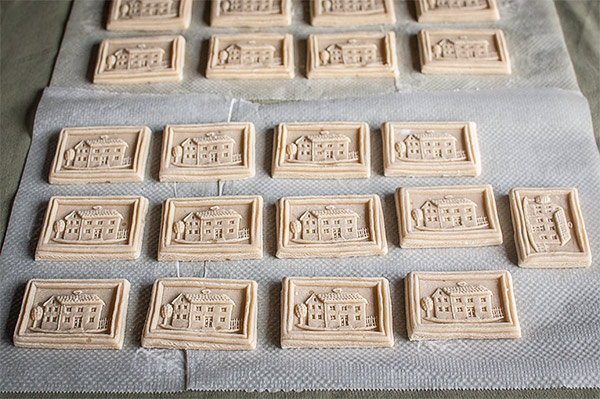
Cuando se tenga las galletas bien secas, se hornean a 90º (con aire) /110º (sin aire) 50-60 minutos.
Estas galletas se caracterizan por ser muy blanquitas, por lo que es fundamental que no se doren.
* Si la primera hornada se dora se bajará algo la temperatura del horno en la siguiente. También se debe bajar la temperatura si la masa sube demasiado o se deforma en exceso, que es algo que ocurre con frecuencia. ** Aunque se inflen algo en la cocción siempre se bajan también después, aunque algunas veces no completamente.
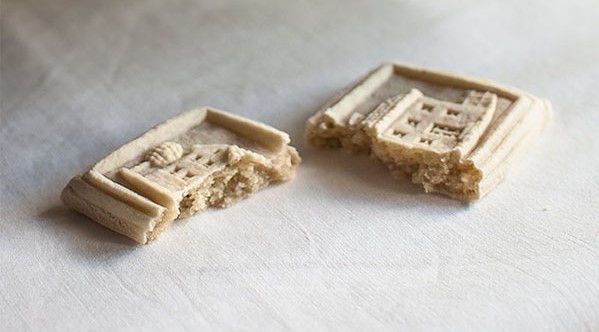
Estas galletas springerle tienen un rico sabor a anís que, aunque en esta receta se ha usado aroma de anís porque es más cómodo, tradicionalmente se les daba horneándolas sobre un lecho de granos de anís machacados.

Christmas with a Taste of Central Europe
This Christmas, we will not be using Grandma Paquita’s recipes. But we will be using the typical recipes of the Central European grandmothers who make this special time of year a charming memory of a family Christmas.
History of Springerle biscuits
Springerle biscuits are beautiful biscuits from Central Europe, i.e. Germany, Switzerland and some of France, traditional for Christmas. They are white, aniseed-flavoured biscuits with an image of different motifs printed on their surface. The images are printed by pressing the dough with wooden rollers or with flat moulds finely carved in wood.
The history of Springerle biscuits goes back almost a thousand years, Germanic tribes during the winter solstice celebration performed animal sacrifices as an offering to the god Wotan (Odin) supreme king of the Norse gods, the horse was considered a sacred animal for these tribes and the word Springerle comes from an old German dialect meaning something similar to «little jumping horse».
Since poor people could not afford to sacrifice their animals, they made animal-shaped biscuits to offer as a sacrifice to the god Wotan.
Today, some traces of these pagan practices still survive in the shapes and engravings of Springerles moulds, with scenes of animals and festivities.
In the Middle Ages, with the inclusion of 25 December in the Christian calendar, the tradition of stamped biscuits continued, replacing pagan designs with Christian motifs. The monastery bakeries that supplied sweets and breads to royalty were the most influential in replacing the old motifs on the Springerle with the religious designs that dominated this period.
The first recipe for Springerle appeared in a cookbook in 1688, these biscuits became very popular between 1600 and 1800 when craftsmen began to make moulds and rollers carved and engraved in wood with intricate and fine decorative details, the designs had an important symbolic meaning: fertility, virility, love, etc., later designs with flowers, fruits and details of everyday life of the time were also incorporated. Most of the moulds from this period are in European museums or private collections.
Springerle moulds are valued as a family treasure that has been passed down through the centuries from mother to daughter along with the old, jealously guarded recipes.
Springerle Cookies
They are characterised by their delicate reliefs, which are retained during firing because they are left to dry for up to a whole day after printing with a mould.
These biscuits are made only with eggs, icing sugar and flour, and it is traditional to flavour them with aniseed.
They have a hard consistency, so they keep very well and are usually left to mature for a week or so before being eaten. Because of their consistency and ease of preservation, they are ideal as gifts (they can be kept for up to three months).
Springerle biscuits have traditionally included a curious ingredient: ammonium carbonate, a chemical leavening agent that predates commercial baking powder.
This component makes the biscuits crispier than with ordinary yeast and helps the patterns stay crisper during baking.
However, it is not essential and it is perfectly possible to bake the biscuits with ordinary yeast.
How to make Springerle Biscuits :
Ingredients
– 3 medium eggs (at room temperature)
– 400 g icing sugar
– 60 g butter
– 1 tsp. aniseed flavouring
– 1/4 tsp. salt
– 1/2 tsp. ammonium carbonate (hartshorn) or chemical yeast
– 500-520 g pastry flour
* Springerle biscuit cutters
Elaboration
Firstly, weigh or measure the flour, salt and the chemical impeller that you are going to use (either yeast or ammonium carbonate) and sieve everything together.
And set aside.
Place the eggs in a bowl and sieve the icing sugar over them. Beat with electric beaters or a food processor with beaters at high speed, until they whiten well and have increased in volume. Keep in mind that you will need to beat for at least 15 minutes.
After the necessary time has elapsed, add the butter at medium speed until blended. Add the aniseed flavouring.
At low speed, add the flour mixture by spoonfuls until it is all incorporated. You should obtain a soft dough that sticks to your fingers.
Put the resulting dough on the floured work surface. Transfer the dough to the floured work surface. Knead it lightly.
* Flour the dough evenly, but lightly, because the more flour the dough absorbs, the harder it becomes.
If it is too sticky, add a little more flour and knead again, but be careful as the dough dries out quickly with just the flour used to prevent it from sticking.
*To find out if the dough is ready, you can roll out a small portion with a rolling pin and apply it to a mould.
If the dough is at the right moisture content, it should not stick to the mould at all and should reflect perfectly to the last detail.
If it sticks to the mould, flour should be added little by little.
Once the dough is ready, take a portion of the dough (between a third and a quarter).
Keep the dough unused; wrap it tightly in plastic wrap so that it does not dry out.
Using the dough to be used, roll it out with a rolling pin to a thickness of 1 cm and apply the mould, pressing hard.
* The mould can be applied as many times as space permits, but not too close to each other, as pressing the mould at one point tends to deform the dough in the vicinity.
** Another method is to cut the corresponding biscuit each time the mould is applied.
The dough offcuts can be used perfectly, gathered together and rolled out again. The dough should always be floured with flour and worked thinly and evenly underneath and only very lightly on top, where the moulds are to be applied.
*On the other hand, if the dough becomes a little dry at some point, add a pinch of water, even if only by wetting your hands, and knead lightly.
Place the cut biscuits (with a knife, cookie cutter or whatever is most convenient for you) on baking paper.
Leave the biscuits to air dry in a cool place for 8 to 24 hours.
When the biscuits are very dry, bake them at 90º (with air) /110º (without air) for 50-60 minutes.
These biscuits are characterised by being very white, so it is essential that they do not brown.
* If the first batch browns, the oven temperature should be lowered slightly for the next batch. The temperature should also be lowered if the dough rises too much or becomes excessively deformed, which is a common occurrence.
** Even if they puff up a little during baking, they are always lowered afterwards, although sometimes not completely.
These springerle biscuits have a rich aniseed flavour which, although aniseed flavouring has been used in this recipe because it is more convenient, was traditionally given to them by baking them on a bed of crushed aniseed kernels.

